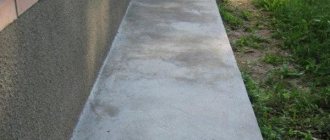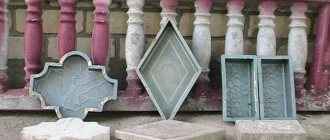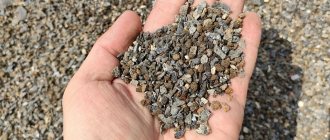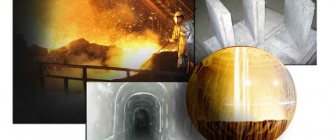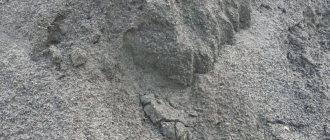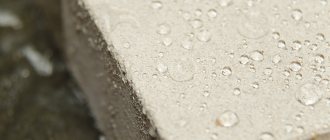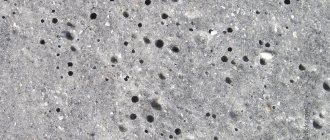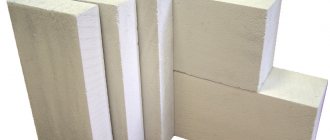Home |Useful articles |Grade of concrete for water resistance: characteristics, features of choice
Date: December 2, 2018
Comments: 1
Concrete is a universal building material that is widely used in construction activities. Reinforced concrete products, main walls of buildings, and interfloor ceilings are traditionally made from it. The material has a number of positive characteristics, one of which is the ability to resist water penetration.
Application
The usual composition allows moisture to pass through. However, situations arise when increased water resistance of concrete is necessary to ensure the required operating conditions of structures. Typical representatives of such structures used in civil engineering are:
- strip foundations;
- basement walls;
- floors in rooms located below the zero level.
When building a foundation or basement, due to the high waterproofness of the material, you can save on waterproofing or purchase a cheaper type of it
The water resistance of concrete is also relevant for industrial hydraulic structures that have direct contact with water and take significant loads:
- Dams.
- Dams.
- Special containers.
- Underwater tunnels.
Let us consider in detail what the waterproofness of concrete is, how it is achieved, how it affects the characteristics of the material, and we will study the specifics of marking.
Ways to increase water resistance
The water resistance of concrete can be increased in various ways. The choice depends on the area where it will be applied:
- By introducing plasticizing additives when changing the water-cement ratio to obtain a more dense material.
- Using aluminous cement.
- Inclusion of aluminum and iron sulfates into the mixture.
- Adding additives and water repellents.
- Using coating compounds and impregnations.
Waterproof criteria
Resistance to moisture penetration under pressure is characterized by the water resistance value of the concrete composition, denoted by the capital Latin letter W together with a digital index ranging from 2-20 and changing in increments of two. Concrete mass according to its ability to pass water under pressure is marked W2, W 4, W 6, W8, W10, W12, W14, W16, W18, W20.
Material based on alumina and high-strength cement has high water resistance
The digital value corresponds to the pressure of the water mass expressed in kgf/cm² (megapascals) on a cubic reference sample, the side of which is 0.15 meters. For example, when marked W8, concrete absorbs water pressure per square centimeter of surface equal to 8 kilograms.
In this case, water does not seep through the material.
With an increase in the digital index, which characterizes the concrete grade for water resistance, the ability of the concrete mass to perceive water pressure increases.
Recipe for concrete mortar
When preparing the solution yourself, follow proven recipes to ensure water resistance. Waterproof concrete contains various ingredients. A budget option is to use liquid glass, added in the following percentages:
- add liquid glass in an amount of up to 10% of the volume of cement when preparing the cement composition for waterproofing;
- add 5-8% sodium silicate when preparing concrete mortar to increase its water resistance;
- mix sodium silicate with Portland cement in equal proportions to prepare protective mixtures.
Before adding modifiers to the concrete composition, carefully study their properties and recommended proportions.
Features of different brands
There is a relationship characterizing the water permeability of concrete and its grade:
- The array, marked W2, corresponds to materials M100-M200, which quickly absorb water and, regardless of thickness, require the mandatory application of a waterproofing layer.
- Concrete W4 corresponds to M250, M300.
It is less permeable to water compared to W2, but is quite hygroscopic. Recommended for use with waterproofing protection. The material is used in civil engineering. The value of water resistance increases with the introduction of additives into the finished concrete solution, ingredients that cause compaction of the mass, as well as the use of cements with an increased coefficient of expansion. The water resistance of concrete is the ability of artificial stone not to allow moisture to pass through under a certain pressure. - Concrete W6 (M350) is characterized by reduced water permeability, which allows it to be widely used in construction and repair activities. The good water resistance of W6 concrete allows it to be used for sealing gaps in reinforced concrete structures, hydraulic insulation of containers, and monolithic structures. It is also used for the construction of basements on soils with closely spaced aquifers.
- W8 concrete is made from high-quality cement, the concrete solution of which is marked M400. The material absorbs only about 4% of moisture from its mass. It has proven itself positively in the performance of foundation work, the construction of tanks, industrial tanks intended for storing liquid compositions, bomb shelters, as well as various hydraulic structures. It is used in residential construction if it is necessary to carry out work on arranging a room that is operated at high humidity.
- Compositions W10-W20 (M450-M600) are characterized by increased water resistance and do not require waterproofing when used. The scope of use of solutions is the construction of critical hydraulic structures, special tanks, concrete tanks for storing liquid substances. The composition W20 has maximum resistance to moisture, which is not used for residential construction and private needs. The composition is characterized by increased frost resistance F200-F300, which allows it to withstand sudden temperature changes.
[testimonial_view id=”26"]
Types of effective additives and their mechanism of action
- Plasticizers: “Suprplasticizer S-3”, “Superplast” and component D5. All types of plasticizers have the same mechanism of action - the formation of a persistent waterproof film around cement particles and the creation of an electrical charge. This greatly activates the finished concrete and it compacts well;
- Colmat additives: bitumen emulsion, calcium nitrate, aluminum sulfate, iron sulfate and nitrate. They also significantly increase the density of the poured structure. The desired effect is obtained as a result of a chemical reaction between the additive, water and the binder - the formation of water-insoluble compounds that reliably “clog” all pores and even significant voids (colmatation process);
- Polymer additives: methyl cellulose, cellulose methyl ether, as well as diethylene glycol, triethylene glycol and polyamide resins. This type of additive provides the highest level of water resistance. The required effect is ensured by enveloping the particles of concrete components and forming a very strong waterproof polymer film on them.
You should know! Only a monolithic concrete structure can be made waterproof: a monolithic foundation, a pool or well bowl, a reservoir, etc. It is impossible to make prefabricated concrete structures 100% waterproof by any means or technologies!
What affects water resistance?
The water resistance of concrete W depends on a number of factors. The main factors influencing the indicator are:
- uniformity of structure associated with the uniform distribution of air cavities in the material. A concrete mass with increased density is characterized by a lower concentration of pores, which increases its resistance to water permeability;
Denser concrete contains a minimum number of pores, so it is more waterproof
- degree of compaction of the solution, shrinkage of the composition, increased concentration of water during mixing. A decrease in the volume of a concrete mass occurs during hardening and is associated with the processes of moisture evaporation during drying. Intensive shrinkage can be caused by insufficient reinforcement with reinforcement, accelerated drying at elevated temperatures;
- the introduction of special additives, plasticizers that help reduce the number of pores, close air cavities, and also increase the density of the mixture, which is associated with the addition of special iron and aluminum sulfates, as well as calcium nitrate. The effect is achieved through the process of vibration impact on the solution, which in the process is compacted with a simultaneous decrease in the percentage concentration of water;
- composition and structure of cement used in the concrete mortar formulation. Increased density is characterized by a composition made on the basis of a high-strength and alumina cement composition, which absorbs moisture during the hydration process, forming a dense mass. The use of Portland cement with pozolanic additives, which significantly increase in volume when hardening, increases the resistance of the mass to moisture;
- the period of time that has passed since the filling. As the age of the monolith increases, its ability to absorb moisture decreases. Over the course of a year after concreting, the ability to resist moisture increases 4-fold compared to the characteristics of the reference sample, which was measured at the age of 4 weeks.
The water resistance of concrete depends on additives
TOP products to add to the composition
Special products will also help improve the waterproofing properties of concrete mortar.
Crystal
The additive is considered the most famous on the Russian market. Dry, odorless powder is added to the concrete mixture. The granules react with salt-based plasticizers. The main advantages are efficiency and reduced consumption of building mixture. Using the product allows you to increase the water permeability of the material to W16, which provides reliable protection against moisture penetration into the concrete body. The strength of the building material doubles, and frost resistance increases by 60 cycles. Concrete can be used to arrange the bottom of a swimming pool or artificial reservoir. Find out about finishing one-component putty for cars in this article.
It is recommended to prepare the concrete mixture in a concrete mixer; the manual method of preparation does not allow achieving the desired quality of the solution. When preparing the mixture, you should strictly follow the instructions.
Fort “UP-1”
A universal multifunctional additive is used in the construction of buildings for various purposes. The product reacts chemically with all types of cement. The action of the additive is aimed at increasing waterproofing properties, increasing frost resistance and density of the mixture. Concrete mortar containing Fort “UP-1” fits perfectly and penetrates into all hard-to-reach places. The additive should be added to the mixture simultaneously with cement and aggregates. The quality of the mixture is achieved under the condition of prolonged mixing, it all depends on the methodology used at the enterprise.
Cost – 600 rub.
Benefits of the supplement:
- saving cement;
- avoiding the formation of efflorescence;
- increased strength;
- protection from aggressive environments;
- ease of use;
- ability to work in any climatic conditions;
- long shelf life.
Superplast S-3
The additive is used to change the characteristics of mortar and concrete over a wide range. The main advantages of the product are versatility, high-quality composition, and precision of impact. The additive is used in the construction of self-leveling floors, in monolithic construction, and in the formation of paving slabs. Adding Superplast S-3 to construction mixtures allows you to obtain impact-resistant smooth surfaces.
Properties:
- increasing the strength of concrete;
- preservation of properties in the temperature range -40 – +85 degrees;
- explosion and fire safety;
- increasing the homogeneity, cohesion, workability of concrete solutions;
- the possibility of replacing high-quality cement with an analogue with a low grade;
- increase in adhesion with reinforcement by 1.5-1.6 times.
When using the additive, it is recommended to use personal protective equipment - special glasses and gloves.
Homemade ways to improve waterproofing
You can also increase the waterproofing properties with improvised means, for this you can use household chemicals, PVA glue, and slaked lime. All components react with the concrete mixture in different ways; compliance with the dosage plays an important role.
All substances must meet the following requirements:
- absence of volatile components in the composition;
- eliminating the use of toxic substances;
- chemical resistance;
- the operating temperature must be higher than the destruction temperature of the additive composition.
Washing powder
Washing powder is used dissolved in water. The optimal effect is achieved by maintaining a proportion of 100 - 150 powder per 50 kg of cement.
When using powder, you should use types intended for automatic washing, since their use produces less foam.
Liquid soap or shampoo
Liquid soap should be mixed with cement in a ratio of 200 ml per bag of cement. When using detergents, preference should be given to products with reduced foaming.
PVA glue
Glue should be added to the solution in a proportion of 200 g per bucket of mixture. Limited use is due to the presence of starch in the composition.
Slaked lime
Chloride of lime is introduced into the mixture simultaneously with other components; its amount should not exceed 20% of the total volume. Unlike the quicklime formula, the additive increases the elasticity of the concrete solution and increases its adhesive properties.
How to increase water resistance?
The task of increasing the water resistance of concrete is relevant both in industrial and civil construction, and when performing concrete work in private settings. It is not always possible to buy a high-quality solution when doing concrete work yourself.
There are the following proven methods to achieve increased durability, making it difficult for water to penetrate through a frozen mass:
- Preventing accelerated shrinkage of the concrete mass during the hardening process, associated with the presence of a high concentration of air cavities. It is through them that moisture penetrates into the thickness of the material. The use of special ingredients helps to form a protective coating on the surface of the mixture, which reduces shrinkage. Preservation of volume is facilitated by moistening the surface with water during the first four days and using a film that impedes the evaporation of moisture.
- Curing concrete products under special conditions. Proper storage conditions, including constant humidity, positive temperature, and the absence of direct sunlight, help increase the material’s ability to resist moisture penetration. With increasing storage time, the concrete mass acquires an increased ability to resist water permeability.
- The use of special coating compositions, which are mastics, emulsions, heated bitumen, which are applied to a previously cleaned, primed surface. The coating is carried out layer by layer until a dense protective crust is formed on the surface. The use of painting waterproofing methods allows you to protect the surface of a concrete mass in a limited time.
Final Recommendations
Waterproof concrete is superior in performance properties to other types of concrete compositions. It is easy to independently increase the waterproof properties of the material in order to make a durable concrete porch, street stairs made of concrete, as well as a moisture-resistant foundation for the garage with your own hands. Moisture-resistant concrete-like plaster will reliably protect the walls of the building; it is prepared with your own hands according to a proven recipe. It is important to carefully study the technology and understand methods for increasing water resistance.
Laboratory methods for determining the indicator
Control methods are regulated by the current standard. The regulatory document establishes the following methods for testing the water resistance of concrete:
- by controlling the magnitude of the maximum pressure that the reference cube through which water is trying to leak can withstand. The method involves exposing moisture to the lower plane of the standard and visually monitoring its resistance as the pressure increases. The value is determined by wet marks on the top edge;
- by calculation, using the value of the filtration coefficient, which characterizes the volume of moisture seeped under a pressure of 1.3 MPa through the array over a certain time. To implement the method, special laboratory equipment is used;
- using an accelerated method that controls the degree of permeability of the sample to air, as well as using special devices - filtrate meters.
If it is necessary to quickly determine water resistance, accelerated control methods are used, since accurate laboratory methods require 5-7 days for testing.
